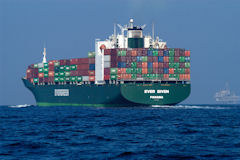West Coast ports import 70% of the Asian trade, and half of that cargo moves to the Midwest and East Coast by means of trains. In effect, that means 35% of the Asian trade will be up for grabs by Hampton Roads and competing ports, when the Panama Canal opens up to larger ships and doubles its capacity in 2015.
That’s a lot of business but there will be a lot of competition for it, as Sara E. Russell, a professor of maritime and supply-chain management at Old Dominion University, makes clear in the latest edition of The Virginia News Letter. Not only are ports along the U.S. East Coast and Gulf Coast gearing up to capture a piece of the action so are ports in the Caribbean, which are positioning themselves as logistical load centers where cargo can be redistributed by smaller feeder ships.
Russell is optimistic that Virginia port, which has the advantage of the East Coast’s deepest channels and some of its best rail connections, has a major growth opportunity. But Virginia can’t take anything for granted, as many other states are moving aggressively to capture business, too. “The Virginia Port, in partnership with the state’s economic development groups,” she writes, “must proactively work to attract the shippers.”
The fantasy scenario for Virginia is for Hampton Roads to become a load center, acting as a hub for Asian-bound exports and the redistribution of cargo from the deep-draft ships to shallow-draft ports and inland facilities. Russell says that the “more realistic” scenario is that several key ports with well-developed infrastructure will receive smaller portions of the increased tonnage. To guard against disruptions from everything from labor disputes to hurricanes, it makes sense for shippers to cover their bets by pursuing dual East Coast/West Coast shipping strategies. Even so, she says, the opportunities are large. She concludes:
It is realistic to assume that because the magnificent deep water Port of Virginia can clearly handle significant cargo volume increases, the impact of the Panama Canal expansion on the state could mean considerable economic growth through shipping manufacturing, distribution, and infrastructure development with corollary job creation. As a result of far-sighted infrastructure projects in place and under way both seaside and landside in Virginia, the state is poised and prepared for higher volumes of cargo when the larger vessels begin moving through the Panama Canal in 2015.
Bacon’s bottom line: Russell provides a solid overview of the economic issues surrounding the Panama Canal expansion but she avoids addressing the tough public policy issues. For example, she does not discuss the state’s billion-dollar public investment in U.S. 460, which the McDonnell administration justifies by the expectation of increased volume of cargo from Panama Canal expansion. How much of the cargo will move by truck, as opposed to railroad? Is it realistic to expect a new industrial development corridor to emerge? How dependent will new economic activity be upon a host of special tax breaks enacted in recent years by the General Assembly? She doesn’t answer those questions. She doesn’t have much to say about the pros and cons of port privatization either, nor does she even tell us how economic developers ought to be collaborating with the port.
In sum, Russell makes a strong case that the Panama Canal expansion represents an opportunity worth pursuing but she doesn’t offer much guidance on how.



